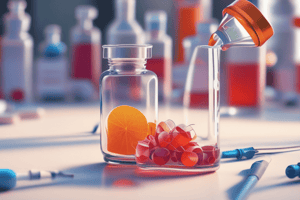Podcast
Questions and Answers
What is the primary purpose of pre-clinical drug testing?
What is the primary purpose of pre-clinical drug testing?
What is the approximate time frame associated with the discovery and eventual marketing of a drug?
What is the approximate time frame associated with the discovery and eventual marketing of a drug?
What is the purpose of randomized controlled trials (RCTs) in drug evaluation?
What is the purpose of randomized controlled trials (RCTs) in drug evaluation?
What is the importance of ethical, rigorous, and peer-reviewed research practices in drug development?
What is the importance of ethical, rigorous, and peer-reviewed research practices in drug development?
Signup and view all the answers
What is the role of the Structure-Activity Relationship (SAR) in drug development?
What is the role of the Structure-Activity Relationship (SAR) in drug development?
Signup and view all the answers
Study Notes
Pre-Clinical Drug Testing
- Pre-clinical drug testing involves evaluating a drug's safety and efficacy in laboratory and animal studies before human testing
- This phase includes in vitro (cell culture) and in vivo (animal) studies to assess pharmacology, pharmacokinetics, and toxicology
Phases of Testing
- Pre-clinical phase: 2-3 years, includes laboratory and animal studies
- Phase I clinical trials: 1-2 years, involves first human testing in small groups of healthy volunteers to assess safety and tolerability
- Phase II clinical trials: 2-3 years, involves testing in small groups of patients to assess efficacy and optimal dosage
- Phase III clinical trials: 3-5 years, involves large-scale testing in diverse patient populations to confirm efficacy and monitor side effects
- Phase IV clinical trials: post-marketing surveillance, ongoing monitoring of drug safety and efficacy after approval
Time Frame of Drug Development
- Discovery to marketing: 10-15 years, includes pre-clinical and clinical testing phases
- Total investment: approximately $1-2 billion per drug
Randomized Controlled Trials (RCTs)
- Definition: RCTs involve randomly assigning participants to either an intervention group (receiving the drug) or a control group (receiving a placebo or standard treatment)
- Importance: RCTs provide unbiased and reliable evidence of a drug's efficacy and safety
- Key elements: randomization, control group, blinding, and sufficient sample size
Need for Ethical, Rigorous, and Peer-Reviewed Research
- Ethical considerations: protect participant safety, ensure informed consent, and maintain confidentiality
- Rigorous research: minimize bias, ensure accurate data collection and analysis, and report results transparently
- Peer-reviewed research: manuscripts undergo critical review by experts to ensure validity and relevance
Structure-Activity Relationship (SAR)
- Definition: SAR is the relationship between a drug's chemical structure and its biological activity
- Importance: SAR helps identify optimal drug targets, predict efficacy, and minimize toxicity
- Role in drug development: SAR guides medicinal chemistry optimization, leading to the development of more effective and safer drugs
Studying That Suits You
Use AI to generate personalized quizzes and flashcards to suit your learning preferences.
Description
Understand the process of pre-clinical drug testing, clinical trial phases, and the time frame from discovery to marketing. Learn about randomized controlled trials, the importance of ethical research practices, and the role of Structure-Activity Relationship in drug development.



